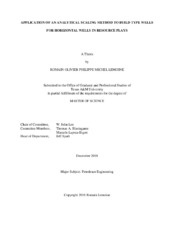| dc.description.abstract | The purpose of type wells is to portray the range of production profiles of a predetermined geological subset in a resource play. Most type well construction workflows rely on the creation of “average” profiles by simply averaging production for all wells in a given geological area, often a subset of a larger resource play. The production profile of empirical averaging cannot be directly associated with a set of reservoir and completion parameters. Relating to “Fetkovich’s Field Type Curve” methodology published in 1987, we show that we can create more representative type wells if we average the wells that are scaled to a common “base well” with known completion and reservoir parameters. Scaling factors are determined by a fit of production data to an analytical solution developed for horizontal wells exhibiting transient linear flow followed by boundary-dominated flow. The scaling factors are influenced largely by matrix permeability, fracture length, fracture spacing, drawdown and lateral length. We use the distribution of permeability and fracture half-length found in the type curve diagnostic to forecast undrilled wells and wells with only short production histories.
Since the fit of production data depends on the geometrical shape of the type curve, we successfully demonstrate that the type curve applies to horizontal multi-fractured wells in known resource plays. We propose an original and integrated workflow based on our scaling methodology that includes the industry’s current best practices to create type wells and characterize a geologically similar area with publicly available data. Using this approach to scale production can dramatically increase the number of analogs and we demonstrate the application of the workflow with 126 wells from the Denton County in the Barnett shale. We observe that the scaling factors reduce the uncertainty of a typical well production for a given set of completion parameters, and provide a reliable tool to probabilistically forecast production. Furthermore, scaling time of underperforming wells in a group improves the durations of “known production” forecast. In conclusion, this analytically-based workflow provides reliable production forecasts and type wells with measured uncertainty. Because type wells are important tools for decision makers and engineers to determine economic feasibility of proposed development projects, more accurate type well construction has financial and strategic implications in the range of millions to billions of dollars. | en |


